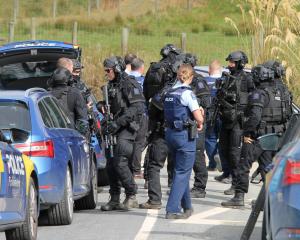Boosted numbers of medical graduates would be a welcome future addition to the health workforce, but "the problem is now", the senior doctor’s union warns.
This follows Labour’s pledge yesterday to increase the national intake of medical students by 62%, the largest ever rise.
As Prime Minister Chris Hipkins announced the plan during a visit to the Otago Medical School, in Dunedin, senior doctors were protesting for better pay and conditions just one block away in Cumberland St.
It was the second national Association of Salaried Medical Specialists (ASMS) strike in two weeks, amid a standoff with employer Te Whatu Ora Health New Zealand (HNZ).

ASMS Southern senior industrial officer Kris Smith said members were "fed up" and she hoped the government would see they were determined to get their message across.
"They have delivered over and above for a very extended period of time and in really difficult circumstances with huge staff shortages."
Pay rates were a barrier to people taking up employment in New Zealand, where they were desperately needed.
It took at least 14 years to train a specialist, and it would be a long time before the increase would deliver meaningful results, she said.
"While it’s really important that we increase those numbers - and it’s really very, very welcome - the problem is now, and we have to find a solution for now."
Obstetrics and gynaecology consultant Kate Coffey was among those at the Dunedin protest yesterday, saying she wanted to show solidarity with colleagues.
"We see that conditions for doctors are untenable and we’re worried about the next generation and keeping the current generation in New Zealand," she said.
Labour’s plan would increase the medical student intake by 95 places each year from 2025 to 2027.
Including the 50 extra places already set to take effect next year, this would bring the total annual intake to 874 by 2027 - an increase of 335.
It would mean a significant - though as yet unspecified - increase for the University of Otago, where the present cap on domestic medical school admissions is 282 students a year, a figure last increased by 35 places in 2015.

By contrast National has promised to build a third medical school at the University of Waikato, and lift the national yearly medical student intake to 759 by 2030.
Mr Hipkins said yesterday that while medical schools would have to work hard to accommodate the change, the feedback was that they could do it.
He did not want to discourage people from spending some time overseas, as they could bring back experience that would benefit the health system.
The issue was making sure they would want to return to New Zealand - a decision that would be based on lifestyle factors, not just the health system.
Health Minister Dr Ayesha Verrall said the doctors on strike would cite workforce shortages as the cause of a lot of the pressure they were under.
"We have to have a sustainable long-term plan to get us back on track with that respect, pay and conditions is absolutely part of it."
National leader Christopher Luxon said Labour’s policy for training more doctors was not credible or believable.
"We are 31 days out from an election and they have only just worked out that we have a health workforce crisis in New Zealand."












